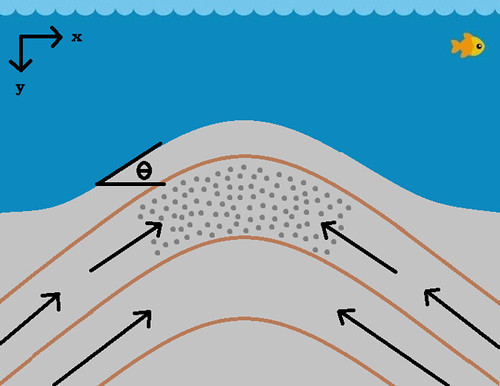
My master's thesis title page.
So I realize that the title probably sounds like a foreign language, so let me explain. What I've been studying is fluid flow through ocean sediments. Sediments, as they fall onto the ocean floor, are continuously being buried, and as they get buried deeper, they are squeezed and compacted. Much like a sponge, the sediments squeeze out any water that might have been trapped when the particles fell to the ocean floor. This fluid that is squeezed out behaves according to physical laws (ie fluid mechanics) and can be described mathematically. Even the environment, like the ocean sediments, can be described mathematically. I have been studying how all these equations come together to describe fluid flow through the ocean sediments. In particular, I am modeling how fluid flow is effected by an anisotropy in the sediment permeability. The permeability of 'something' (in this case being ocean sediments) is a word that described how easy it is for a fluid to flow through it. If the permeability of the sediments is anisotropic, it means that fluid can flow through it easier in one direction than another. In nature, it is often found that fluid can flow easier laterally (side-to-side) through sediments than vertically (up-and-down). So if you introduce topography, it might be able to focus fluid flow through the sediments, like in the picture:

Fluid flow might be focused up and into the topographic high on the sea floor. The stripes represent different fluid layers. The arrows represent fluid flowing.
So what's the point of all this? Well, those gray dots in the picture are supposed to represent methane hydrate, a reservoir of methane gas (a.k.a. natural gas) that is frozen in ice. Its so cold underneath the ocean floor that some water trapped in the sediments freezes, and within the ice crystals, methane gas is trapped. The methane comes from bacteria that eat organic things in the sediments. In fact, most of the sediments are made of dead ocean animals, so the methane is coming from their decomposition, aided by bacteria. The point is that there is A LOT of methane trapped in this way under the ocean floor, and its relevant to study how fluid (which carries dissolved methane gas) flows through the ocean sediments, especially since the accumulation of methane hydrate is mostly found under topographic highs. Basically, there are mountains and canyons underneath the ocean, just like there are on land, and underneath the mountains, it seems that methane hydrate accumulates more than in other places. So there. . . hopefully the title is not as mysterious now.

0 comments:
Post a Comment